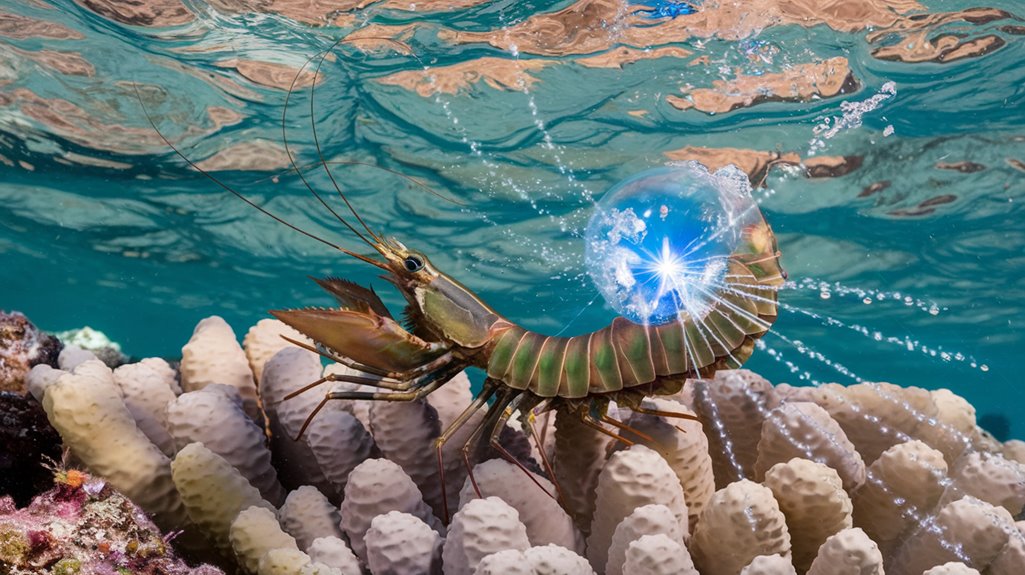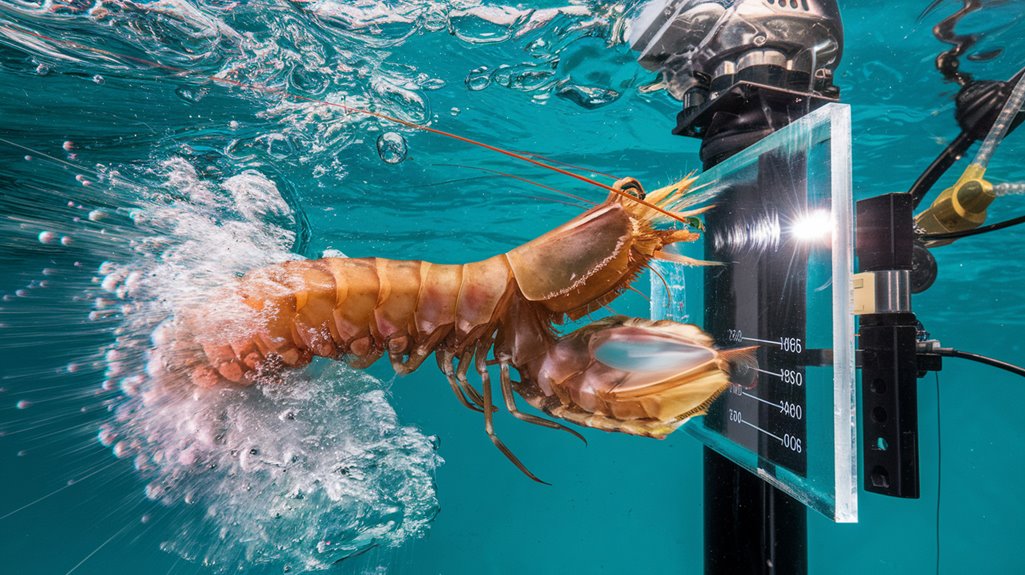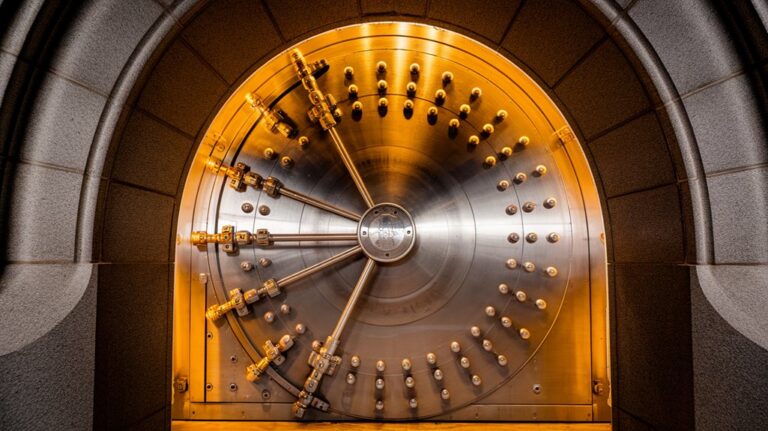Mantis Shrimp Punch With the Force of a Bullet
You've probably never heard of a creature that can crack aquarium glass with a single blow, but the peacock mantis shrimp does exactly that. This small but mighty crustacean packs a punch that rivals a .22 caliber bullet, delivering strikes at an astounding 50 miles per hour. While it's only about the size of your thumb, don't let its diminutive stature fool you—there's much more to learn about this underwater boxer's remarkable arsenal of weapons.
Meet Nature's Most Powerful Puncher
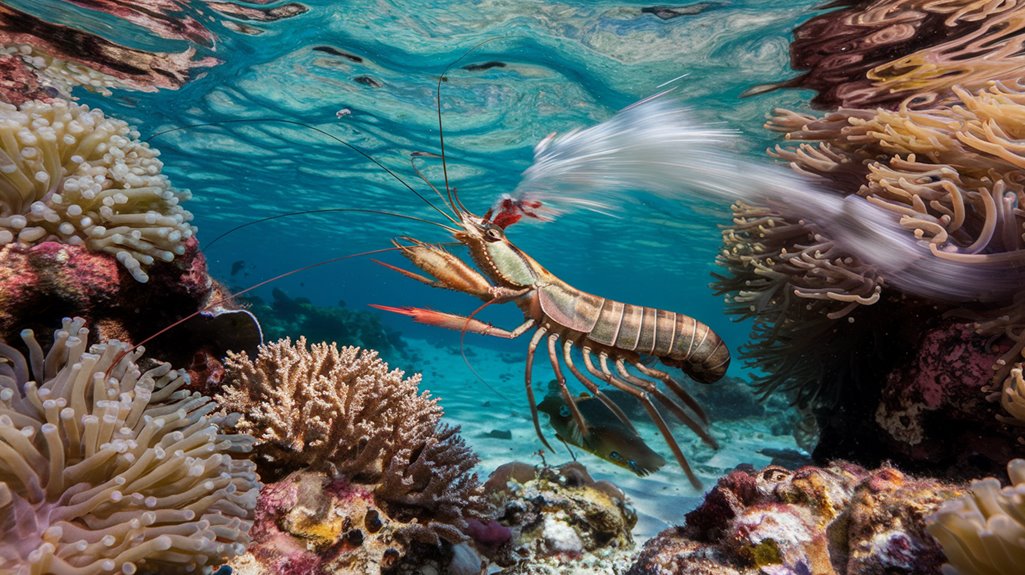
The mantis shrimp, nature's knockout artist, packs a punch that'll make you question everything you know about small creatures. At just 8 to 10 inches long, this colorful predator lurks in tropical coral reefs and rocky crevices, waiting to release its devastating attack on unsuspecting prey. These remarkable creatures utilize their complex eye structure to track and accurately target their prey with precision.
You won't believe the mantis shrimp's behavior when hunting – it strikes with the force of a 22-caliber bullet, generating 15,000 newtons of pure power. That's 2,500 times its body weight! With an evolutionary history spanning 80 million years, these creatures have perfected their powerful striking capabilities.
Using a unique spring-loaded system in its specialized claws, it delivers a double whammy to its victims: first with the physical impact, then with a powerful shockwave. Whether spearing fish or crushing crabs, this mighty marine warrior has mastered the art of the lightning-fast knockout punch.
The Science Behind the Lightning-Fast Strike
Behind that lightning-fast knockout punch lies an engineering marvel that would make any physicist's jaw drop. The mantis shrimp's appendage works like a sophisticated spring-loaded system, where energy storage happens in specialized saddle and ventral bars before releasing with explosive force.
What makes this natural weapon so remarkable? Here's the fascinating science:
- The strike generates forces up to 1500 N – that's 2500 times the shrimp's body weight.
- The punch moves at 45 mph, creating underwater cavitation bubbles that produce light and heat.
- Different parts of the claw show varying mechanical sensitivity, allowing the shrimp to fine-tune its strike without losing power.
This powerful mechanism has evolved over 250 million years, resulting in a biological acceleration that muscles alone couldn't achieve. The strike's incredible power comes from the coordinated action of antagonistic muscle pairs working together during the loading phase. The acceleration of the strike is so extreme that it matches the speed of a .22 caliber bullet when released.
Engineering Marvel: The Unbreakable Club
While most natural weapons would shatter under the extreme forces of repeated high-speed impacts, the mantis shrimp's club stands as nature's ultimate example of damage-resistant engineering.
You'll find that its remarkable material resilience comes from an intricate layered design. The exterior features a calcium-based mineral coating, while the interior contains mineralized fibers arranged in circular patterns. The club's efficiency is enhanced by its hydrodynamic teardrop shape that cuts through water with minimal resistance.
What makes this biological engineering masterpiece truly exceptional is its spiral structure of blended materials, including chitin. These specialized structures allow the mantis shrimp to strike with speeds over 50 mph, powerful enough to break aquarium glass.
When you examine the club's composition, you'll notice how it efficiently channels potential cracks along these spiral pathways instead of splitting straight through.
This innovative design has inspired scientists to develop materials that are 20% stronger than conventional ones, leading to breakthroughs in aerospace technology, protective gear, and sports equipment.
Dual Impact: How the Double Punch Works
When you examine a mantis shrimp's punch, you'll discover it's actually two devastating blows in one. This double impact starts with a strike as fast as a bullet, reaching speeds of 23 meters per second. The rapid motion creates a fascinating physical phenomenon – a cavitation bubble that implodes and delivers a powerful secondary punch. The strike's immense force generates up to 15,000 newtons of raw power.
The four bar mechanism precisely controls this remarkable punching action. This evolutionary advantage gives the mantis shrimp an incredibly efficient hunting mechanism. Here's how the dual strike works:
- The shrimp releases stored elastic energy through its spring-loaded system.
- The initial blow hits the target with tremendous force.
- The cavitation bubble collapses, creating a secondary shockwave.
The combination of biological springs, latches, and specialized claw materials makes this double punch mechanism possible, turning the mantis shrimp into one of nature's most formidable predators.
From Ocean Depths to Human Innovation
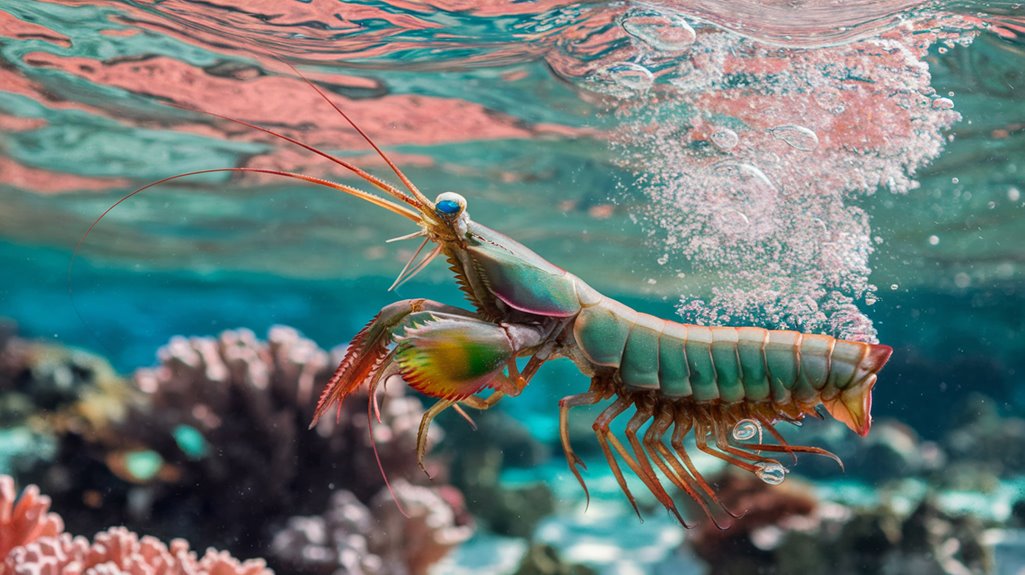
Through millions of years of evolution, the mantis shrimp's remarkable punch has inspired groundbreaking innovations across multiple fields.
You'll find scientists studying these powerful predators from marine habitats to develop everything from advanced robotics to protective gear.
The mantis shrimp's unique shell structure, composed of hydroxyapatite and chitin, has caught the attention of material scientists who are working to create stronger, lighter armor for military and sports applications.
Their specialized raptorial appendages enable them to strike with incredible force, making them fascinating subjects for engineering research.
These unique creatures make their homes in U-shaped burrows within coral reefs and sandy areas, creating an ideal base for their powerful hunting strikes.
Engineers have already developed robots that mimic the creature's lightning-fast strike, which could revolutionize small-scale robotics.
Beyond their predator roles, these creatures have sparked interdisciplinary collaboration between biologists, engineers, and roboticists.
Their natural design could lead to transformative technologies in industries where durability and power in compact forms are essential.
Breaking Records and Breaking Glass: Real-World Impact
Despite their small size, mantis shrimp pack a punch that rivals some of nature's most formidable forces. Their remarkable punching power stems from an efficient energy storage system, allowing them to strike with the same acceleration as a bullet from a 22-caliber gun.
You might be surprised by what these tiny creatures can accomplish with their explosive strikes:
- They can shatter quarter-inch thick aquarium glass with a single blow.
- Their punches generate cavitation bubbles that reach temperatures of 4,400C.
- They deliver double impacts – first from the strike itself, then from the bubble's shockwave.
Scientists are now studying these incredible creatures to develop better protective armor and robotic materials. The unique composition of their club-like appendages could revolutionize how we approach material engineering and impact resistance. Their specialized claws contain a remarkable nanoparticle coating that absorbs and disperses the enormous forces generated during their strikes. The structure has survived for 400 million years, predating even the dinosaurs.

